Cat Stevens
Mona Bone Jakon
Tea for the Tillerman
Teaser and the Firecat
A&M/Universal
Meticulously remastered and restored with original artwork, these three albums put Cat Stevens on the map in America. Born Steven Demetre Georgiou, Stevens had already experienced a degree of fame with some fluffy pop hits in Britain (most forgettably “I Love My Dog”) during the late 60’s. But after a bout with tuberculosis laid him up for over a year, Stevens tapped into a soul-searching period that resulted in this incredible hat trick of releases tumbling out in 1970 and 1971.
With his deep, smooth, honey-sandpaper voice and ideal production by Paul Samwell-Smith (guitarist/bassist for the Yardbirds, of all things), who was as much an architect of the immaculate sound and texture of these albums as was its star, Stevens rolled out the 32 tracks on these three discs in less than 24 months, and three decades later they sound just as emotionally trenchant, if a bit dated, as when they were originally released.
The first, 1970’s Mona Bone Jakon, is remarkably relaxed, self-assured and sophisticated with “Lady D’Arbanville,” a moderate hit single, setting the tone with subtle, often unusual percussion, lush orchestration and eclectic instrumentation (Peter Gabriel – just starting out in Genesis at the time – contributes flute), as well as truly bizarre nasal, humming backing vocals which oddly work perfectly with the sound. Fans of the cult flick Harold And Maude will recognize “Maybe You’re Right” and “Trouble,” which were prominently featured in the soundtrack. “I See the Light” is as powerful and intense a guitar-less soft rocker as you’ll hear, and the offbeat, nonsense lyrics to the short (1:26) title track show another side to Stevens whose wordless vocal wailing at the song’s end is chilling.
Stevens must have written a surplus of material while recuperating, because a second 1970 album, Tea for the Tillerman, rolled out another eleven tunes which not only built on the tension and detailed songwriting of the previous album, but upped the ante with timeless classics like “Where Do the Children Play?,” “Father and Son,” and his first full-fledged US hit, “Wild World.” These songs, and indeed the rest of the album, haven’t aged a day, as their effortless, flowing melodies and sympathetic arrangements remain subtly powerful and Stevens’ unique vocals add the perfect touch. Hidden gems like “On the Road to Find Out,” again featuring innovative backing vocals, cymbal-less, almost tribal drums, and even Stevens’ haunting organ abound, making this a virtually perfect album and an undisputed masterpiece of its era. Released in the same year as Mona Bone Jakon, it established Stevens as a major, even THE major British singer/songwriter of his time.
Recorded in 1971, Teaser and the Firecat, a song cycle of sorts for an animated children’s tale, added elements of Stevens’ roots in “Rubylove,” which featured a Bouzoukia-a stringed instrument common in traditional Greek music. Otherwise it was business as usual, with ten terrific songs. “Morning Has Broken,” “Moonshadow,” and of course, “Peace Train,” all interestingly stuffed at the end of the album, were the big hits, but they weren’t necessarily the best tunes. “Tuesday’s Dead,” with its Afro-Cuban percussion, and the rhythmic, spiritually oriented “Bitterblue” were just as good.
The sound on these albums was always first-class, even when they were first released on vinyl, but the sparkling, newly remastered editions make it seem like Stevens is in the same room with the listener. Warm, atmospheric, and immediate, the music has never sounded better. Those who missed it the first time have another chance to tap into some of the best – and oddly, least celebrated – folk-rock of the early 70’s. Each disc is a masterpiece in its own right. Even though the hits can be found on the recently issued Very Best of Cat Stevens, nothing can capture the magic of hearing these enduring songs in their original context.












